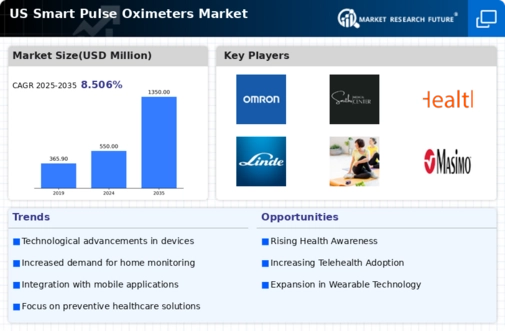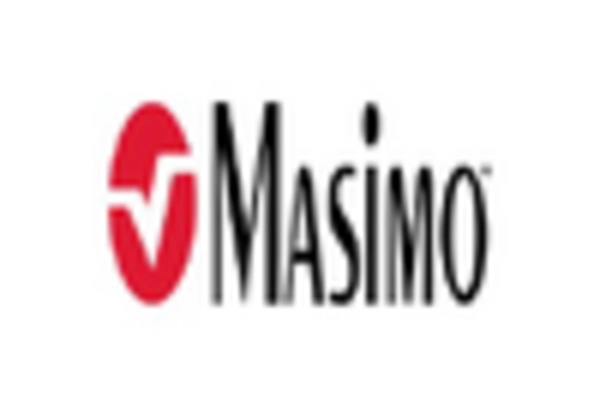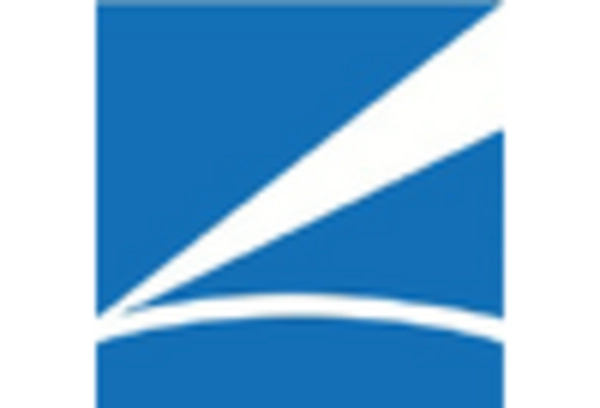Increased Focus on Preventive Healthcare
The smart pulse-oximeters market is benefiting from an increased focus on preventive healthcare measures. As healthcare systems shift towards preventive strategies, there is a growing emphasis on early detection and management of health conditions. Smart pulse-oximeters play a crucial role in this paradigm by enabling individuals to monitor their oxygen saturation levels regularly. This proactive approach not only aids in early diagnosis but also empowers patients to take charge of their health. The preventive healthcare market is projected to grow significantly, with estimates suggesting a CAGR of around 7% through 2025. This trend is likely to bolster the demand for smart pulse-oximeters, reinforcing their importance in the healthcare landscape.
Advancements in Wearable Health Technology
Advancements in wearable health technology are driving innovation within the smart pulse-oximeters market. The increasing popularity of wearable devices that monitor various health metrics has led to the development of more sophisticated pulse-oximeters. These devices now offer features such as mobile app connectivity, sleep tracking, and fitness monitoring, appealing to a broader consumer base. The wearable technology market is expected to reach $60 billion by 2025, indicating a robust growth potential. As consumers become more health-conscious and seek integrated health solutions, the smart pulse-oximeters market is likely to experience significant expansion, fueled by these technological advancements.
Growing Prevalence of Respiratory Diseases
The rising prevalence of respiratory diseases in the US is a critical driver for the smart pulse-oximeters market. Conditions such as asthma, COPD, and other chronic respiratory ailments necessitate regular monitoring of oxygen levels. Recent statistics indicate that approximately 30 million Americans suffer from asthma, while COPD affects around 16 million individuals. This growing patient population creates a heightened need for effective monitoring solutions, positioning smart pulse-oximeters as vital tools in disease management. As healthcare providers emphasize proactive monitoring to improve patient outcomes, the smart pulse-oximeters market is poised for substantial growth.
Rising Demand for Home Healthcare Solutions
The smart pulse-oximeters market is experiencing a notable surge in demand for home healthcare solutions. This trend is driven by an increasing preference for remote patient monitoring, which allows individuals to manage their health from the comfort of their homes. According to recent data, the home healthcare market is projected to grow at a CAGR of approximately 8.5% through 2027. As patients seek to monitor their oxygen saturation levels and overall health status without frequent hospital visits, smart pulse-oximeters are becoming essential tools. This shift not only enhances patient convenience but also reduces healthcare costs, making it a pivotal driver in the smart pulse-oximeters market.
Integration of Smart Technologies in Healthcare
The integration of smart technologies into healthcare is significantly influencing the smart pulse-oximeters market. With the advent of IoT and AI, these devices are evolving to offer enhanced functionalities, such as real-time data sharing with healthcare providers. This capability is crucial for timely interventions and personalized care. The market for connected health devices is expected to reach $100 billion by 2026, indicating a robust growth trajectory. As healthcare systems increasingly adopt digital solutions, the demand for advanced smart pulse-oximeters that can seamlessly integrate with other health monitoring systems is likely to rise, thereby propelling the market forward.

















Leave a Comment